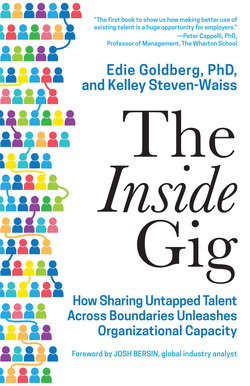Читать книгу The Inside Gig - Edie Goldberg - Страница 6
На сайте Литреса книга снята с продажи.
ОглавлениеFOREWORD
Goldberg and Steven-Waiss’s book addresses an enormous and existential topic: the new world of work. We are all now “gig workers,” even those of us with full-time jobs in large well-managed companies.
Let me explain. Over the last decade, digital tools and digital business models have transformed businesses in every industry. Retailers are digital sales and distribution companies; banks are digital commerce and service companies; and workers in healthcare, pharmaceutical companies, professional services and other industries are all now powered by digital tools.
The big change is not the tools or the technology: it’s how they’ve changed the way we work. In my latest study of talent trend (2019), more than 35 percent of companies say they’ve shifted from hierarchy to network as their primary organization model. Most of us now work on projects and programs, our real job description is more of an estimate of what we do. And in a company where our value is driven by our contribution to the team, each of us have to make sure our skills and teamwork capabilities are up to date.
I often call this the biggest disruption of all—rewiring a company to operate in a digital way, not just build digital solutions.
In this world where we focus on work, not jobs, we are all in a sense gig workers now. Sometimes we carry on the responsibilities of our job description, but often we help others, contribute to a project, or lend our expertise to others. Internal talent mobility, an area of HR which was often neglected, is now one of the most important elements of talent management—forcing business and HR leaders to rethink what high potential really means.
And as far as leveraging external talent, this is an enormous new opportunity for companies. My latest study (2019) found that more than 35 percent of all workers operate in some gig fashion (full time or as a side hustle), yet only 12 percent of companies even know who their gig workers are. Companies often have 30–40 percent of their workforce on some contingent contract, but few have standards for hiring, management, development, and cultural integration of these people. This is all good stuff for HR to focus on, and this book will show you how.
Finally, this new world of highly interconnected teams, operating on projects around the world, demands a new type of leadership. The leaders of the future are often younger (40 percent of employees now work for someone younger than they are) and more interconnected, and they act more as a coach and enabler and less as a “boss.” As gig workers, we are really responsible for our own successes and careers, so we need leaders who can facilitate and empower people in this kind of company.
As the book title describes, if you can learn how to leverage gig work for everyone, you can unleash untapped talent and drive organizational growth. This book will serve as a guide, and I think every business and HR leader should read it carefully.
Best wishes for the new world of work—the opportunities for all of us are endless!
Josh Bersin, global industry analyst
(www.joshbersin.com)
